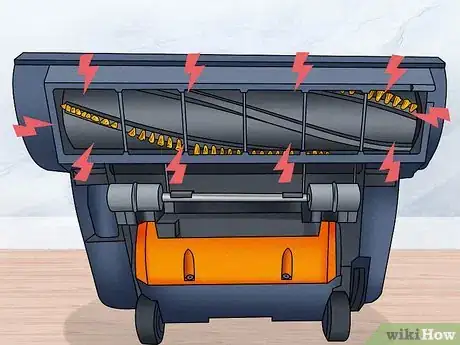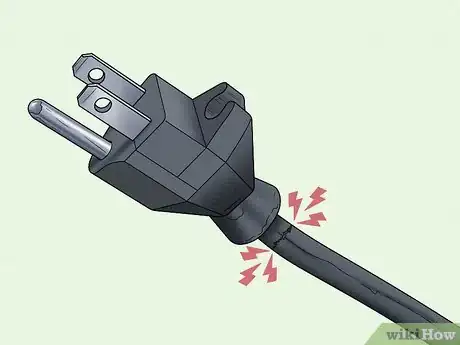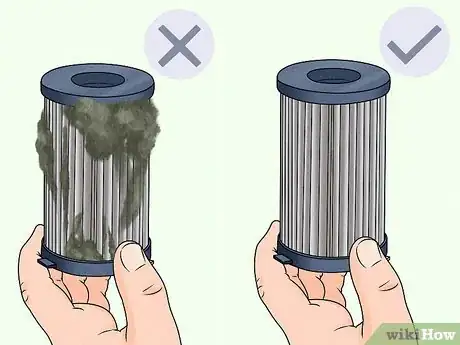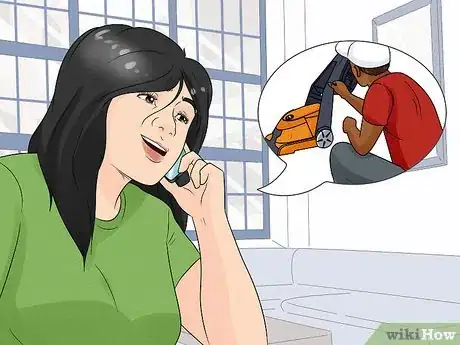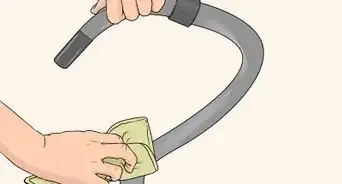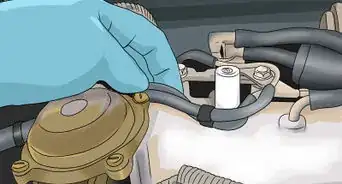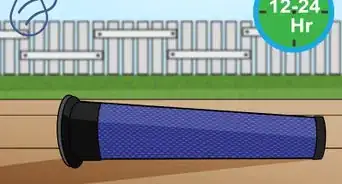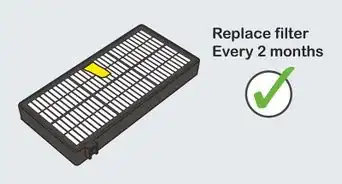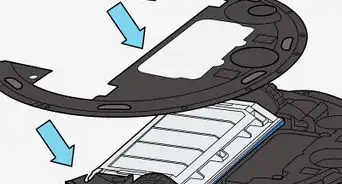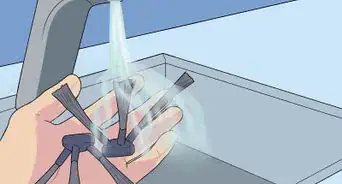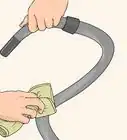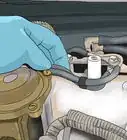This article was co-authored by Chris Willatt and by wikiHow staff writer, Christopher M. Osborne, PhD. Chris Willatt is the owner and founder of Alpine Maids, a cleaning agency in Denver, Colorado started in 2015. Alpine Maids has received Angie's List Super Service Award for three years in a row since 2016 and has been awarded Colorado's "Top Rated Local House Cleaning" Award in 2018.
There are 8 references cited in this article, which can be found at the bottom of the page.
This article has been viewed 580,913 times.
Instead of tossing out and replacing a vacuum cleaner that has lost suction or has other issues, why not try fixing it yourself first? You may be surprised to discover how many vacuum problems can be repaired at home, and this article answers many of the key questions you might have. So read on to find out if you can give your vacuum cleaner a second lease on life!
Steps
What caused it to stop working?
-
1Check the hoses, filters, and rollers if you have a suction problem. A vacuum that loses suction is pretty useless, but the problem is often nothing more than a clogged roller, hose, or filter. To inspect these parts, unplug your vacuum, then turn it over and see if you can manually spin the roller. Look through the hoses and nozzles to see if they are obstructed. Also, check the filter to see if it’s full or covered in dirt and dust.[1]
- Look for clogs in the hose attachments as well.
-
2Inspect the belt if the vacuum is noisy or the roller isn’t moving. The belt attaches the motor to the roller that helps pick up dirt and debris. If the vacuum starts making a high-pitched noise and the roller stops spinning, unplug the vacuum and flip it so you can see the underside (the part that skims over the floor). Open the bottom plate, usually by removing a few screws, and check if the belt is cracked or broken.[2]
- You've probably never shopped for replacement vacuum cleaner belts before, but don't worry—they're widely available at home improvement stores and online.
- If you can’t find the problem, visit a vacuum repair shop to have it looked at by a technician.
Advertisement -
3Check the plug if the motor keeps cutting off or won't start up. Your vacuum cleaner’s power cord can handle a lot of abuse, but it may eventually crack, split, or fray—especially near the plug. With the vacuum unplugged, carefully inspect the entire run of the power cord and plug. If you spot any damage, don’t use the vacuum until you fix the cord yourself or have a repair person do the job.[3]
- If the power cord looks fine, there's probably an issue with the motor. Fixing a bad motor isn’t a DIY job—take the vacuum to a repair shop.
How can I improve low suction?
-
1Empty the bag or canister if it’s full of sucked-up debris. If you have a bagged vacuum cleaner, unplug it and undo the clip to open the bag compartment. Slide out the cardboard collar on the bag that connects it to the vacuum, then slide on the collar of the new bag and close the compartment. If you have a bagless canister vacuum, unclip the canister, open the lid, and dump the debris into a trash can. Do this outdoors so you don’t get dust everywhere![4]
- Check the product manual for specific instructions.
-
2Inspect the filter and clean or replace it as needed. Your vacuum cleaner has at least 1 filter, and maybe several of them! There’s usually one at the exhaust vent (where air blows out when the vacuum is running) and, if it’s a bagged vacuum, where the bag connects to the appliance. Check your product guide or the manufacturer’s website for specific info on finding, cleaning, and replacing filters.[5]
- If the filter is dirty, take it outdoors and tap it against a hard surface to knock out dust and debris. But make sure the breeze is blowing the dust away from you!
- Some filters can be rinsed under cool water after you've knocked loose most of the debris. After rinsing your filter, let it dry for at least 24 hours before reinstalling it.
- Change the filter(s) every 3-6 months to keep your vacuum running efficiently.
Expert Q&A
Did you know you can get expert answers for this article?
Unlock expert answers by supporting wikiHow
-
QuestionWhat kind of vacuum cleaner is the best?
 Chris WillattChris Willatt is the owner and founder of Alpine Maids, a cleaning agency in Denver, Colorado started in 2015. Alpine Maids has received Angie's List Super Service Award for three years in a row since 2016 and has been awarded Colorado's "Top Rated Local House Cleaning" Award in 2018.
Chris WillattChris Willatt is the owner and founder of Alpine Maids, a cleaning agency in Denver, Colorado started in 2015. Alpine Maids has received Angie's List Super Service Award for three years in a row since 2016 and has been awarded Colorado's "Top Rated Local House Cleaning" Award in 2018.
House Cleaning Professional Allshark is the brand that I'm most fond of, but honestly there are plenty of great options out there. Sharks and Dyson also have great vacuums. You just want to make sure that it has a really good roller brush and some strong suction power. Beyond that, it's totally a matter of personal preference.
Allshark is the brand that I'm most fond of, but honestly there are plenty of great options out there. Sharks and Dyson also have great vacuums. You just want to make sure that it has a really good roller brush and some strong suction power. Beyond that, it's totally a matter of personal preference. -
QuestionHow do you clean a vacuum if it isn't working right?
 Chris WillattChris Willatt is the owner and founder of Alpine Maids, a cleaning agency in Denver, Colorado started in 2015. Alpine Maids has received Angie's List Super Service Award for three years in a row since 2016 and has been awarded Colorado's "Top Rated Local House Cleaning" Award in 2018.
Chris WillattChris Willatt is the owner and founder of Alpine Maids, a cleaning agency in Denver, Colorado started in 2015. Alpine Maids has received Angie's List Super Service Award for three years in a row since 2016 and has been awarded Colorado's "Top Rated Local House Cleaning" Award in 2018.
House Cleaning Professional I'd start by cleaning off the brush, since that's going to be the dirtiest part. If it gets super filthy, your vacuum may not function correctly. You may need to use a screwdriver or a coin to access the roller and remove it to clean it by hand. From there, you can use soap, water, and a sponge or microfiber cloth to clean that compartment out. If there's a clog in the hose, you can typically get that out by bending and maneuvering the hose back and forth.
I'd start by cleaning off the brush, since that's going to be the dirtiest part. If it gets super filthy, your vacuum may not function correctly. You may need to use a screwdriver or a coin to access the roller and remove it to clean it by hand. From there, you can use soap, water, and a sponge or microfiber cloth to clean that compartment out. If there's a clog in the hose, you can typically get that out by bending and maneuvering the hose back and forth. -
QuestionWhat do I do if my hose is cleaned out, but it's still not sucking?
 Community AnswerNo suck means no air flow. Check the obvious, the bag (if you have one), the various filters (HEPA), and finally the beater bar head, where the machine meets the carpet. Most vacuums allow easy access to this point of dirt sucking, usually to change a beater bar drive belt and usually you need a Phillip's screwdriver, the one which has a tip like a plus sign. Here, beyond that belt cover is your trouble. You may end up needing a stiff piece of wire, or needle-nose pliers. When you see the obstruction, you'll utilize whatever you've got to clear it out, and get back to work.
Community AnswerNo suck means no air flow. Check the obvious, the bag (if you have one), the various filters (HEPA), and finally the beater bar head, where the machine meets the carpet. Most vacuums allow easy access to this point of dirt sucking, usually to change a beater bar drive belt and usually you need a Phillip's screwdriver, the one which has a tip like a plus sign. Here, beyond that belt cover is your trouble. You may end up needing a stiff piece of wire, or needle-nose pliers. When you see the obstruction, you'll utilize whatever you've got to clear it out, and get back to work.
Warnings
- Make sure your vacuum is unplugged at all times while you’re working on it.⧼thumbs_response⧽
References
- ↑ https://www.cnet.com/how-to/add-more-power-to-your-vacuum-clean-it-the-right-way/
- ↑ https://www.consumerreports.org/vacuum-cleaners/how-to-replace-your-vacuum-cleaner-belt/
- ↑ https://www.smartvacuumguide.com/replace-a-vacuum-cleaner-power-cord/#content
- ↑ https://youtu.be/JMVLDggdKsk?t=23
- ↑ https://www.goodhousekeeping.com/uk/house-and-home/household-advice/a672278/how-to-clean-your-vacuum-cleaner/
- ↑ https://www.goodhousekeeping.com/uk/house-and-home/household-advice/a672278/how-to-clean-your-vacuum-cleaner/
- ↑ https://www.cnet.com/how-to/add-more-power-to-your-vacuum-clean-it-the-right-way/
- ↑ https://www.consumerreports.org/vacuum-cleaners/how-to-replace-your-vacuum-cleaner-belt/
- ↑ https://www.smartvacuumguide.com/replace-a-vacuum-cleaner-power-cord/#content
About This Article
Most vacuum cleaners are relatively simple to fix once you locate the problem. If you have a suction problem, check the hoses and filters to make sure they’re not clogged. You should also turn the vacuum upside down and remove any debris that’s preventing the roller from spinning. If the vacuum is noisier than usual or isn’t rolling, you may need to replace the belt, which is located on the inside of the bottom of the vacuum. If your vacuum doesn’t turn on, or if it starts and stops randomly, you’ll need to replace the plug. If a new plug doesn’t fix anything, the inside motor is probably broken. This part will need to be fixed at a vacuum repair shop. To learn how to replace a vacuum filter, read on!

